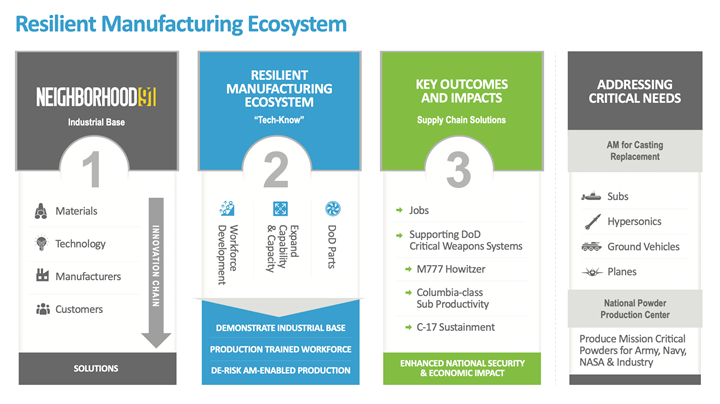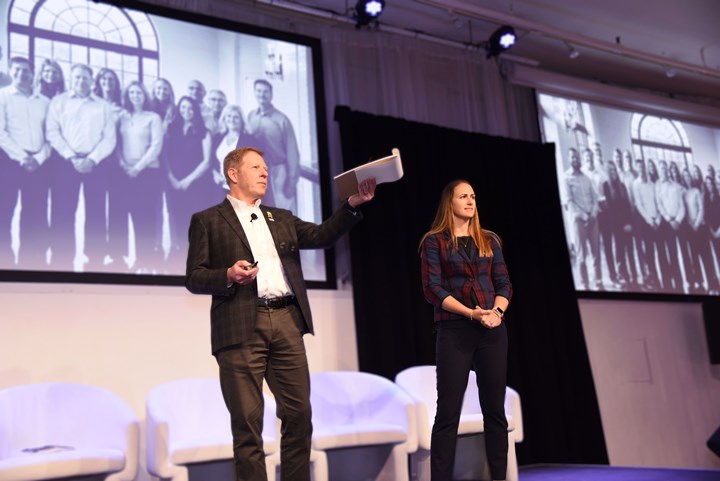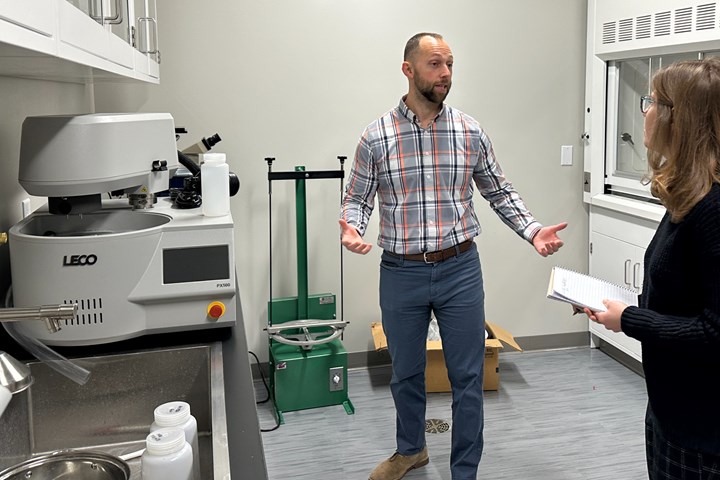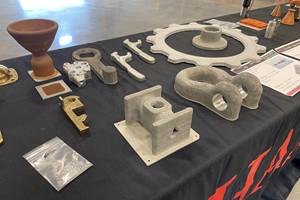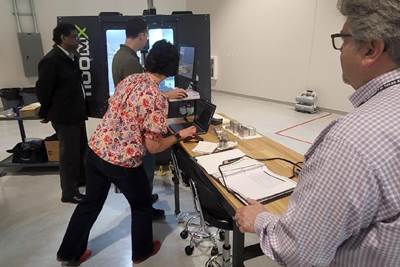Additive manufacturing has immense promise as a solution for spare parts, castings and various other items plagued by supply chain delays and shortages. But acting on this promise first requires a considerable amount of groundwork. Just outside of Pittsburgh, Pennsylvania, a project is coming together to lay that groundwork for the production of critical defense parts. The project aims to develop an ecosystem that not only supports flexible, on-demand manufacturing but one that is self-reliant and replicable as well.
In 2023, consultancy group The Barnes Global Advisors (TBGA) was awarded $1.975 million to “demonstrate a self-sustaining advanced manufacturing production campus tied to critical part needs” for the Department of Defense (DoD). Now in 2024, efforts are well underway to establish that self-sustaining model at Neighborhood 91, an additive manufacturing-focused campus located adjacent to the Pittsburgh International Airport.
Neighborhood 91 tenants Cumberland Additive, HAMR Industries and Metal Powder Works are among the key partners in developing the Resilient Manufacturing Ecosystem. Tenants are not obligated to participate, but the openness for collaboration that brought these companies here has made the campus an efficient testing ground for the concept.
Led by TBGA, the companies occupying this space (including materials producer Metal Powder Works, contract manufacturers HAMR Industries and Cumberland Additive, and analysis company RJ Lee Group) as well as off-campus partners are collaborating on solutions to produce critical parts on demand through additive manufacturing. The project’s scope includes identifying the needs in materials, hardware, software, workflow and human resources to make this possible.
RME Goals and Deliverables
Funding for the Resilient Manufacturing Ecosystem came through DoD’s Industrial Base Analysis and Sustainment (IBAS) Program’s National Imperative for Industrial Skills (NIIS), and this origin has informed its work.
The RME “is a workforce development program first and foremost,” says Jennifer Coyne, The Barnes Global Advisors’ director of programs and a leader of this undertaking.
The location for the project was selected in part because of this workforce consideration; in addition to the collaborative nature of the Neighborhood 91 campus, Pittsburgh also offers the chance to collaborate with Carnegie Mellon University and other schools educating the next generation of engineers, as well as access to a manufacturing workforce that can benefit from training in additive.
But in total, the RME will have four pillars of deliverables:
- Workforce development, focused on training and upskilling professionals in its immediate region.
- Cybersecurity, a necessary part of a project aiming to distribute a defense-focused supply chain. (Technology institute CyManII is part of this work.)
- Demonstrating and validating AM workflows to securely deliver critical components as needed.
- Documenting the methodology such that similar manufacturing ecosystems can be replicated across the U.S. and abroad to support defense work.
John Barnes and Jennifer Coyne are leaders of the Resilient Manufacturing Ecosystem project, pictured here on stage at Additive Manufacturing Strategies 2024. Source: The Barnes Global Advisors
Local Collaboration for Global Impact
The Resilient Manufacturing Ecosystem is in its early days, but already the project has conducted training workshops to address skills needs, and is diving into DoD part databases to identify opportunities for AM. Specifically, the project is investigating opportunities where parts that can be 3D printed to reduce procurement time and exceed legacy performance. RME aims to address long lead times for cast and forged components across all DoD platforms, but pump and valve components for ships and undersea vehicles are a main focus right now.
While the specific parts evaluated cannot be shared publicly, the collaborative nature of the work might look something like this: Metal Powder Works may supply raw material to HAMR Industries to produce a part via cold spray that has been identified as suitable for additive. That part might be stress relieved in a furnace supplied by RME funding, and then finish machined at Cumberland Additive. This entire workflow would be documented and validated by TBGA to support the RME mission.
Michael Schmitt of HAMR Industries shows me the company’s metallurgy lab which includes a polishing system (left) provided through RME funding. Other equipment such as a stress relief furnace and structured light inspection system will also be added to the campus. (As overseer of the project the new equipment belongs to TBGA and will remain on campus regardless of who the tenants are.)
Work like this could be accomplished by shipping parts and supplies among a series of project partners, but the undertaking is far more efficient when many of the companies involved are located together in the same building. Neighborhood 91 tenants are not obligated to participate in the RME, but the opportunity for collaboration is part of what brought many of these companies to the campus in the first place.
“We’re getting companies into the campus that want to be here and create the reality that they need,” says John Barnes, founder of TBGA and co-founder of MPW. “You come here because you want to be a part of this system.”
Yet while Neighborhood 91 arguably provides the best possible environment to develop a Resilient Manufacturing Ecosystem, the goal is not to contain the RME to this location. If the Pittsburgh project is successful, it will provide a blueprint for how to replicate a Resilient Manufacturing Ecosystem in other locations closer to warfighters — for instance in Hawaii or Guam.
“This model eventually goes elsewhere,” Coyne says.
Related Content
3D Printed Replacement Clamp for an F-16 Aircraft: The Cool Parts Show #54
3D printing is a valuable addition to sustainment programs, but only if printed parts can be qualified as fast and flexibly as they can be made. In this episode of The Cool Parts Show, we look at the clamp that won the Air Force’s Approval Sprint Challenge designed to address this need.
Read MoreSintavia Develops Niobium Printing Technology for Aerospace, Defense
C103 material parameter specification is said to enable full alloy adoption across defense and space applications.
Read MoreAdditive Manufacturing for Defense: Targeting Qualification
Targeting qualification in additive manufacturing for the defense industry means ensuring repeatability as well as reliability as there is much at stake, including human lives. Certain requirements therefore must be met by weapons systems used by the defense industry.
Read MoreNeighborhood 91 Expands, With Metal Powder Works and HAMR Now Open
Ribbon cuttings for the Pittsburgh campus's newest tenants coincided with the announcement that a DOD-funded resilient manufacturing program will also be developed at the site.
Read MoreRead Next
The DOE-Funded Institute Working to Make Manufacturing More Secure
National research institute CyManII is working to protect U.S. manufacturing competitiveness, with efforts that touch on training, energy efficiency and cybersecurity.
Read MoreWhat Is Neighborhood 91?
With its first building completely occupied, the N91 campus is on its way to becoming an end-to-end ecosystem for production additive manufacturing. Updates from the Pittsburgh initiative.
Read MoreAdditive Manufacturing for Defense: Targeting Qualification
Targeting qualification in additive manufacturing for the defense industry means ensuring repeatability as well as reliability as there is much at stake, including human lives. Certain requirements therefore must be met by weapons systems used by the defense industry.
Read More

.jpg;width=70;height=70;mode=crop)







